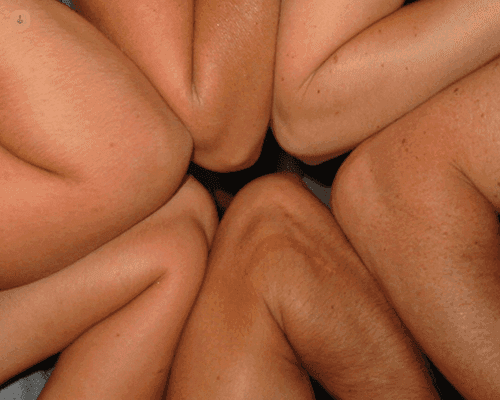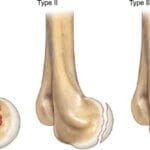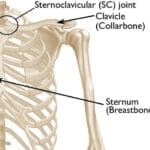The elbow is an extremely fragile part of the human body and can become inflamed and severely swollen if not taken care of properly. Cubital tunnel syndrome is a condition that can affect the elbow and can occur quite frequently if we bang our elbow off firm objects. Here to talk us through the condition in more detail is experienced consultant orthopaedic surgeon, Professor Mohamed Imam.
What is cubital tunnel syndrome?
Cubital tunnel syndrome is a term used to describe ulnar nerve entrapment at the elbow. Cubital tunnel syndrome occurs when the ulnar nerve, which passes through the cubital tunnel (a tunnel of muscle, ligament, and bone on the inside of the elbow) is injured and becomes inflamed, swollen, and irritated.
The cubital tunnel is the tunnel of tissue where the ulnar nerve travels under a bump of bone inside the elbow. This bony bump is called the medial epicondyle. The spot where the nerve runs under the medial epicondyle is commonly referred to as the funny bone. The nerve is close to your skin at the funny bone and bumping it against an object can tend to cause a shock-like feeling.
The ulnar nerve is one of the three primary nerves in the arm. It travels from the neck down into the hand and can be compressed in multiple places along the way, such as beneath the clavicle (collarbone) or at the wrist level. The most typical area for compression is behind the inside part of the elbow. Ulnar nerve compression at the elbow is called cubital tunnel syndrome.
What are the symptoms?
Patients usually present with dull aching pain on the inside of the elbow, with most symptoms occurring in the hands. These symptoms typically include tingling in the ring and little fingers, especially when the elbow is bent.
Some people wake up at night when their fingers are numb. Patients with cubital tunnel syndrome usually report the feeling of the ring and little fingers “falling asleep” especially when the elbow is bent.
Finally, if the nerve is compressed for a long period of time, you can develop severe muscle wasting in your hand. Once this happens, muscle wasting is irreversible. For this reason, it is essential to consult your physician if symptoms are severe or if they are less severe but have been present for more than six weeks.
What are the causes of cubital tunnel syndrome?
In most cases, the precise cause is unknown. We know that the ulnar nerve is especially vulnerable to compression at the elbow as it travels through a confined space with little soft tissue to protect it.
Several factors can cause pressure on the nerve at the elbow. Bending on your elbow for long periods can place tension on the nerve. When your bend your elbow, the ulnar nerve must stretch around the bony crest of the medial epicondyle.
Unfortunately, this stretching can irritate the nerve, and keeping your elbow flexed for long periods or repeatedly bending your elbow can cause painful symptoms. That is why when many people sleep with their elbows bent, they wake up at night with their fingers asleep. In some people, the nerve is unstable, and the nerve slides out from behind the medial epicondyle when the elbow is bent. Over time, this sliding back and forth may irritate the nerve.
Repetitive use of the elbow can cause fluid build-up in the elbow, ultimately leading to swelling that may compress the nerve. A straight blow to the elbow can produce pain, electric shock, and numbness in the little and ring fingers.
Some other causes can put you at risk of exhibiting cubital tunnel syndrome. These include:
- arthritis of the elbow
- a hobby that involves repeated or prolonged activities that require the elbow to be bent or flexed
- swelling of the elbow joint
- previous injury of the elbow

How does it differ from carpal tunnel syndrome?
Carpal tunnel syndrome is a common condition that causes pain, numbness and tingling in the hand and arm. It occurs when one of the major nerves to the hand (the median nerve) is squeezed or compressed as it travels through the wrist.
Patients with carpal tunnel syndrome experience numbness, tingling, burning, and pain, primarily in the thumb and index, middle, and ring finger with occasional shock-like sensations that radiate to the thumb and index, middle, and ring fingers.
Are there any home remedies or exercises to help?
There are many things you can do at home to help relieve symptoms. The most helpful of home remedies include:
- Avoid activities that require bending the arm for long periods.
- When using a computer regularly, make sure that your chair is not too low and do not rest your elbow on the armrest.
- Avoid leaning on the elbow or putting pressure on the inside of your arm. For example, do not drive with your arm resting on the open window.
- Keep your elbow straight at night when you are sleeping by wrapping a towel around your straight elbow or wearing an elbow pad backwards.
How is cubital tunnel syndrome treated?
Unless your nerve compression has induced muscle wasting, your surgeon will most likely initially recommend non-surgical treatment.
If your symptoms have just started, your physician may suggest an anti-inflammatory medicine, such as ibuprofen, to help reduce swelling around the nerve. Although steroids, such as cortisone, are very effective anti-inflammatory medicines, steroid injections are generally not used because there is a risk of damage to the nerve.
To help the treatment process speed along nicely, your physician may also prescribe a padded brace or splint to wear at night to keep your elbow in a straight position. Some experts, meanwhile, believe exercises will help the ulnar nerve slide through the cubital tunnel at the elbow and the Guyon’s canal at the wrist. This is believed to ultimately improve symptoms. These exercises may also help prevent stiffness in the arm and wrist.
Surgical treatment
Your physician may recommend surgery to take pressure off of the nerve if:
- non-surgical methods have not improved your condition
- the ulnar nerve is very compressed
- nerve compression has caused muscle weakness or damage
There are a few surgical procedures that will relieve pressure on the ulnar nerve at the elbow. Your orthopaedic surgeon will talk with you about the option that would be best suited for you.
Cubital tunnel release
In this operation, the ligament roof of the cubital tunnel is cut and divided. This increases the size of the tunnel and decreases pressure on the nerve. After the procedure, the ligament begins to heal, and new tissue grows across the division.
The new growth heals the ligament and allows more space for the ulnar nerve to slide through. Cubital tunnel release tends to work best when the nerve compression is mild or moderate, and the nerve does not slide out from behind the bony ridge of the medial epicondyle when the elbow is bent.

Ulnar nerve anterior transposition
In the majority of cases, the nerve is moved from its place behind the medial epicondyle to a new place in front of it. Moving the nerve to the front of the medial epicondyle prevents it from getting caught on the bony ridge and stretching when you bend your elbow. This procedure is called an anterior transposition of the ulnar nerve.
The nerve can be moved to lie under the skin and fat on top of the muscle (subcutaneous transposition), within the muscle (intermuscular transposition), or under the muscle (submuscular transposition).
Medial epicondylectomy
Another option to release the nerve is to remove part of the medial epicondyle. This technique also prevents the nerve from getting caught on the bony ridge as well as from stretching when your elbow is bent.
What is life like after the treatment?
Cubital tunnel syndrome can be treated with rest and prescribed medicine to help with pain and inflammation. Exercises may help too. In some cases, surgery may be necessary and subsequently performed.
Can cubital tunnel syndrome return after having surgery? If so, why?
Depending on the type of surgery you have, you may need to wear a splint for a few weeks following the operation. A submuscular transposition usually requires a longer time (three to six weeks) in a sling.
Your surgeon may recommend physiotherapy exercises to help you regain strength and motion in your arm. They will also talk with you about when it will be safe to return to your normal activities.
How can cubital tunnel syndrome be prevented?
There are many ways to prevent cubital tunnel syndrome. The main preventative measures include the following:
- keep your arms flexible and strong
- avoid resting on your elbows – especially on a hard surfaces
- warm-up before exercising or using your arms for sports or other repetitive movements
- keep your arm straight while at rest.
- wear a splint while you sleep to prevent the elbow from bending.
- try to avoid falls or direct impact to the inside of the elbow (near the funny bone)
Professor Mohamed Imam is a highly esteemed consultant orthopaedic surgeon who specialises in treatment of the elbow, shoulder, and wrist but to name a few. If you are concerned about any of these aforementioned areas of the body, make sure to head over to Professor Imam’s Top Doctors profile to book a consultation.





